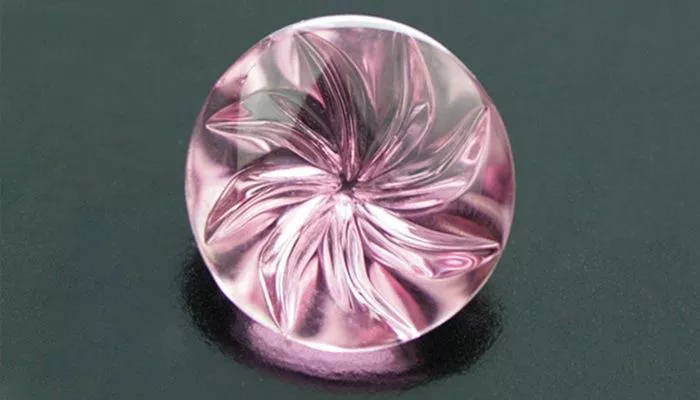Gemstones captivate us with their beauty and unique properties. Among the colorful options available, pink tourmaline and opal stand out for their distinct characteristics. This article explores the characteristics of the pink tourmaline and opal stones, the production process, the identification method, the historical and cultural significance, and the maintenance method. Here are the details:
Pink tourmaline
peculiarity
Pink tourmaline is a gemstone of high hardness, high refractive index and attractive color, usually appearing deep pink, light pink or purplish red. Its hardness is 7.5-8, which is more suitable for making jewelry. Pink tourmaline has a high refractive index, usually between 1.65-1.69, which makes its color very bright and attractive. The color of pink tourmaline is usually formed by the presence of elements such as manganese and iron.
Production technology
Pink tourmaline is usually made by mining, cutting and polishing. During the mining process, rocks or sediments containing pink tourmaline ore need to be excavated and sent to a processing plant for processing. During processing, diamond cutting tools are used to cut the ore into the right shape and size, and polished and polished to bring out the shine and beauty of the gemstone.
Identification method
The identification method of pink tourmaline includes the following aspects:
1. Color identification: the color of pink tourmaline is usually pink or purple, and it is necessary to observe and compare with the naked eye to determine whether its color meets the standard.
2. Hardness identification: The hardness of pink tourmaline is 7.5-8, which can be measured using a hardness meter.
3. refractive index identification: The refractive index of pink tourmaline is very high, usually between 1.65-1.69, and can be measured using a refractometer.
4. Chemical composition identification: The color of pink tourmaline is usually formed by the presence of elements such as manganese and iron, and can be identified using chemical testing methods.
See also: 6 Origins of Pink Tourmaline: A Quick Guide
Opal
peculiarity
Opal is a white or gray gemstone that usually takes on a texture and color similar to protein. Its hardness is 5-6, more suitable for making jewelry. Opals have a low refractive index, usually between 1.52 and 1.53.
Production technology
Opals are usually made by mining, cutting and polishing. During the mining process, rocks or sediments containing opal ore need to be excavated and sent to a processing plant for processing. During processing, diamond cutting tools are used to cut the ore into the right shape and size, and polished and polished to bring out the shine and beauty of the gemstone.
Identification method
The identification method of opal includes the following aspects:
1. Color identification: the color of opal is usually white or gray, and it is necessary to determine whether its color meets the standard by naked eye observation and comparison.
2. Hardness identification: the hardness of opal is 5-6, which can be measured using a hardness tester.
3. refractive index identification: opal has a low refractive index, usually between 1.52 and 1.53, which can be measured using a refractometer.
4. Chemical composition identification: the chemical composition of opal is mainly silicate, which can be identified using chemical testing methods.
Comparison: Physical Properties
Hardness: Pink tourmaline is harder than opal, with a hardness of 7 to 7.5 compared to opal’s 5.5 to 6.5. This makes pink tourmaline more durable for everyday wear and less prone to scratches.
Specific Gravity: Pink tourmaline has a higher specific gravity (3.0 to 3.3) than opal (around 2.15), contributing to its denser feel.
Crystal Structure: Pink tourmaline has a definitive crystalline structure, while opal is amorphous, lacking a crystalline form.
Comparison: Origins and Availability
Sources: Both pink tourmaline and opals are sourced from various countries worldwide. Pink tourmaline is particularly abundant in the United States, Brazil, and Madagascar, while opals are renowned for their deposits in Australia, Ethiopia, and Mexico.
Rarity: Pink tourmaline can be found in a range of qualities and sizes, making it more readily available than pink opals. Pink opals are relatively rare and highly valued for their unique play of color.
Comparison: Appearances and Color
Color Range: Pink tourmaline offers a broader range of pink hues, from delicate pastels to deeper pinks with a slight purplish tint. Pink opals, on the other hand, display a delicate pink hue combined with the mesmerizing play of color.
Opacity: Pink tourmaline is typically translucent to opaque, allowing for a wide range of cutting styles and designs. Opals, due to their play of color, can vary in opacity, but many are translucent, enhancing the visual effect of the play of color.
Comparison: Cultural Significance and Applications
Cultural Meanings: Pink tourmaline is associated with love, compassion, and creativity, making it a popular choice for romantic jewelry. Opals, in general, are believed to possess healing powers and protective qualities, with pink opals specifically associated with love and nurturing energy.
Jewelry Applications: Both pink tourmaline and pink opals are highly versatile in jewelry design. Pink tourmaline’s hardness and durability make it suitable for a wide range of settings, including rings, earrings, and pendants. Pink opals, due to their softer composition, are often set in protective mountings to prevent damage.
Conclusion
Pink tourmaline and opal are two different gemstones, and they have obvious differences in color, hardness, refractive index and chemical composition. When choosing and buying jewelry, you need to choose the right gemstone according to your own preferences and needs. At the same time, when wearing and maintaining jewelry, it is also necessary to pay attention to the characteristics and maintenance methods of gemstones to ensure the beauty and life of gemstones.
Related topic:
- What Is Pink Tourmaline Worth: The Value of a Pink Gemstone
- Rubellite VS Pink Tourmaline: Is it the Same?
- Enchanting Elixir: The Healing Properties of Pink Tourmaline


